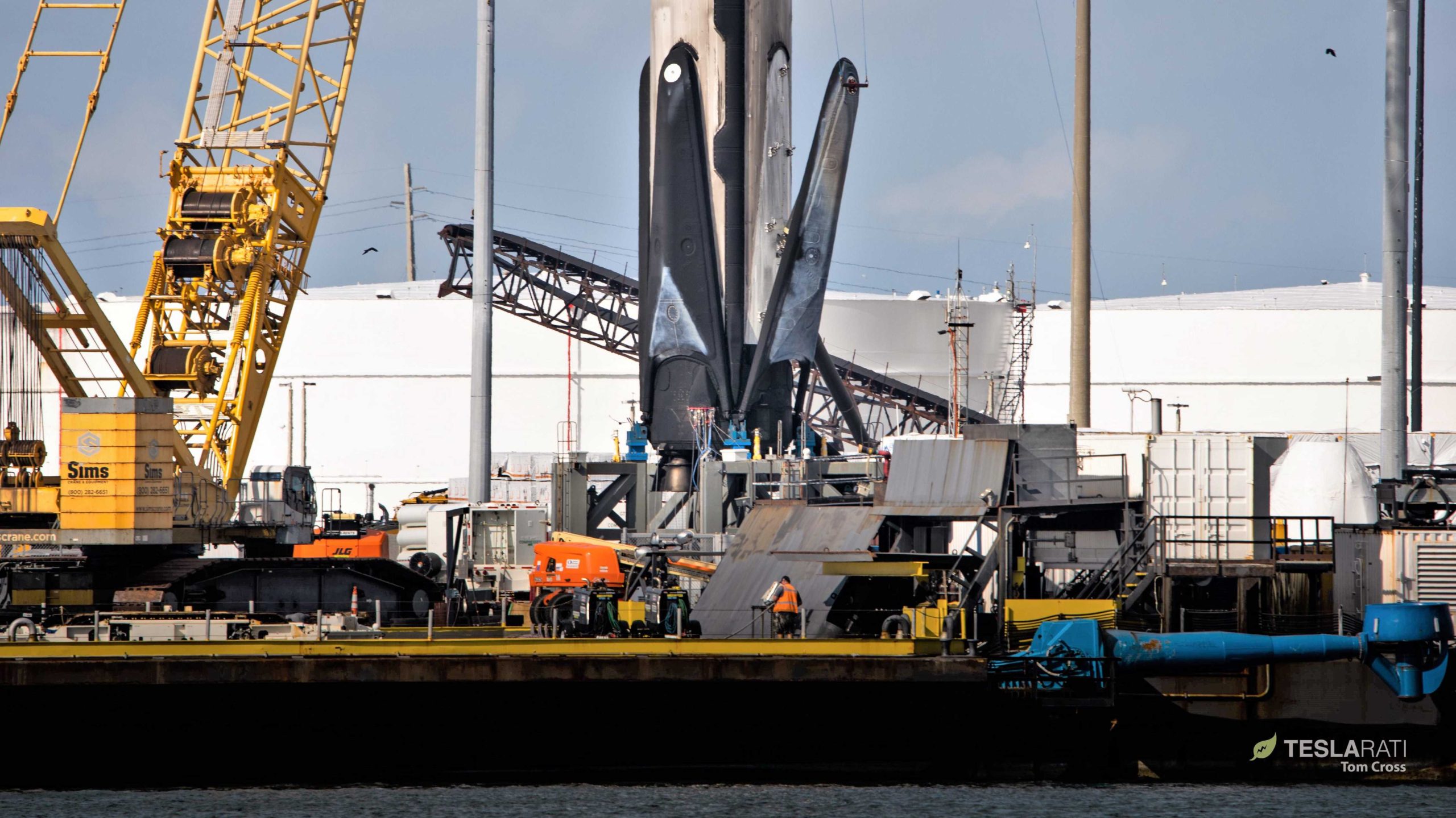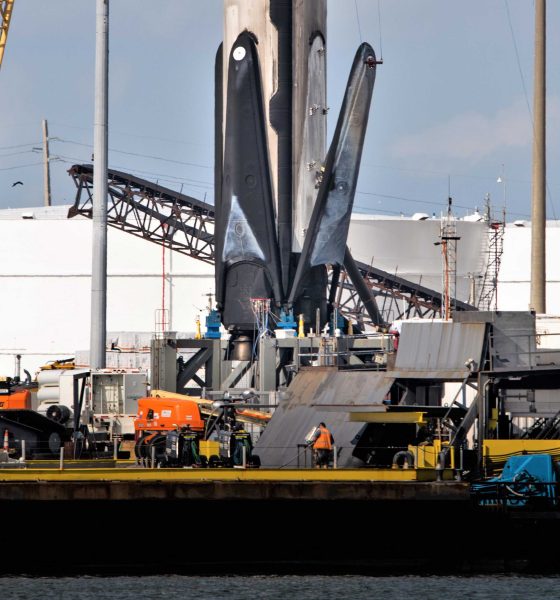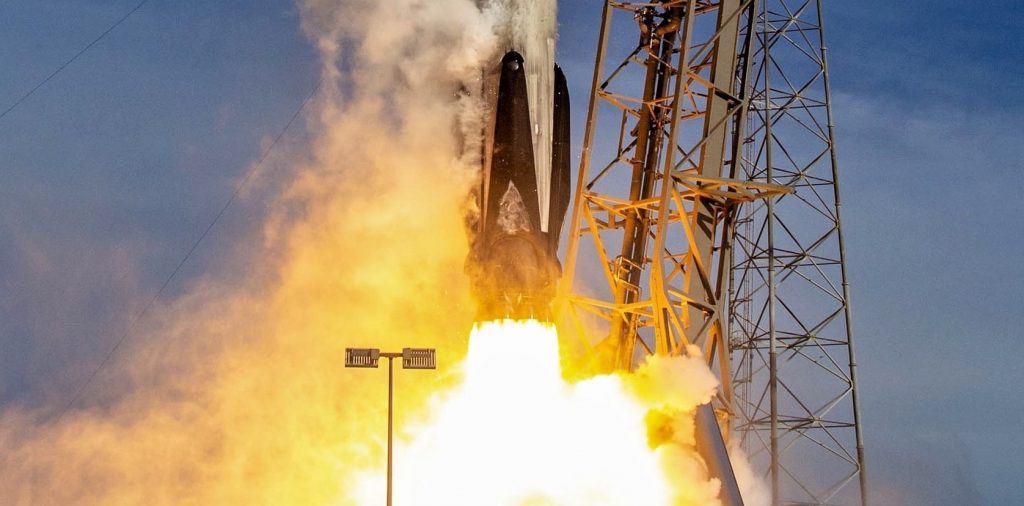

News
SpaceX retracts Falcon 9 booster’s landing legs a second time after speedy reuse
Following the Falcon 9 booster’s second successful NASA launch in less than three months, SpaceX recovery technicians have once again rapidly retracted B1056’s four landing legs, also reused from the booster’s May 2019 launch debut.
On the heels of Falcon 9 B1056’s first speedy, leg-retracting recovery, a repeat of the booster’s impressive landing leg retraction debut – using the same legs, no less – serves as an excellent sign that whatever hardware changes were implemented are on the right track. As part of SpaceX and CEO Elon Musk’s interim goal of launching the same Falcon 9 booster twice in 1-2 days, a speedy recovery is an absolute necessity, and landing leg retraction is just one of the dozens of ways the company will need to optimize recovery and reuse to lower average turnaround times from weeks to days.
Falcon 9 B1056 completed its successful launch debut on May 4th, 2019, landing on drone ship Of Course I Still Love You (OCISLY) to preserve an ongoing Crew Dragon failure investigation at Landing Zones 1 and 2 (LZ-1/2). Situated just a few dozen miles off the coast of Florida, OCISLY returned to port with the booster barely a day after the landing, easily the fastest drone ship return yet.
Less than two days after arriving at Port Canaveral, SpaceX technicians had already begun the landing leg retractions in what was the first actual attempt in months. Falcon 9 Block 5 debuted back in May 2018 with comments from Musk indicating that retractable legs were one of several major reusability-focused changes, but SpaceX recovery technicians never got beyond a handful of partial tests in the second half of 2018.
This ended with a truly flawless full retraction of all four landing legs on May 7th, confirmed when booster B1056 was flipped horizontally, loaded onto a powered transporter, and driven back to a SpaceX refurbishment facility with all four scorched legs installed.
Even more impressively, although it’s impossible to know if the retracted legs were removed, inspected, and reattached during refurbishment, all four of those legs were unambiguously flown again on B1056’s second launch less than three months later. Some cursory analysis of photos of CRS-18 taken by SpaceX, NASA, and others definitively identifies all four landing legs as the same ones that flew on CRS-17 – installed in the same positions, no less.


At least in the context of the Falcon family of rockets, SpaceX’s ultimate goal is to dramatically lower the cost of Falcon 9 and Heavy launches by quickly, easily, and safely reusing every part of the rocket except its orbital upper stage, which makes maybe 10-15% of hardware costs. A magnitude reduction in costs is thus out of the question for the Falcon family – a challenge that will be tackled instead by Starship and Super Heavy, a new clean-sheet launch vehicle.
Nevertheless, it’s entirely possible that Falcon 9 missions will be able to launch for 3-5 times less than their current list price ($62M) within a year or two and definitely before the family is replaced by its successor(s). In fact, according to CEO Elon Musk, SpaceX has already lowered the average base price nearly 20%, cutting it to $50M to communicate some of the financial rewards of efficient reuse to its customers.
Of course, it’s important to remember that even if SpaceX gets to a point where it could technically cut its launch prices in half (or more), breaking even on a marginal cost basis does not account for SpaceX’s desire to recoup some of the $1B+ it has spent perfecting Falcon reusability. The fact that prices have (at least according to Musk) been lowered a decent amount is a good sign that SpaceX will choose market expansion over greed, but one can never be certain and Falcon 9 and Heavy pricing may very well never reflect their true reusability.
For now, SpaceX’s rapid progress from zero landing leg retraction to retracting the same booster’s same four landing legs twice in less than three months is an excellent sign that Block 5’s capabilities continue to be refined. In terms of milestones, the first launch of a thrice-flown booster is up next for Falcon 9, as is the first reuse of a recovered Falcon fairing half (or two).
Check out Teslarati’s Marketplace! We offer Tesla accessories, including for the Tesla Cybertruck and Tesla Model 3.

News
Tesla Full Self-Driving gets sparkling review from South Korean politician
“Having already ridden in an unmanned robotaxi, the novelty wasn’t as strong for me, but it drives just as well as most people do. It already feels like a completed technology, which gives me a lot to think about.”

Tesla Full Self-Driving got its first sparkling review from South Korean politician Lee So-young, a member of the country’s National Assembly, earlier this week.
Lee is a member of the Strategy and Finance Committee in South Korea and is a proponent of sustainable technologies and their applications in both residential and commercial settings. For the first time, Lee was able to utilize Tesla’s Full Self-Driving technology as it launched in the country in late November.
Her thoughts on the suite were complimentary to the suite, stating that “it drives just as well as most people do,” and that “it already feels like a completed technology.”
드디어 오늘, 서울에서 테슬라 FSD 체험 했습니다.
JiDal Papa님의 모델S 협찬에 힘입어^^ 파파님 정말 감사합니다.
국회 -> 망원시장 -> 홍익대 -> 국회 복귀 코스였고요.
이미 무인 로보택시를 타봐서 그런지 신기함은
덜했지만, 웬만한 사람만큼 운전을 잘하네요.이미 완성된 기술이라고… pic.twitter.com/8pAidHBpRG
— 이소영 국회의원 (Soyoung Lee) (@im_soyounglee) December 17, 2025
Her translated post says:
“Finally, today I got to experience Tesla FSD in Seoul. Thanks to the Model S sponsored by JiDal Papa^^, I’m truly grateful to Papa. The route was from the National Assembly -> Mangwon Market -> Hongik University -> back to the National Assembly. Having already ridden in an unmanned robotaxi, the novelty wasn’t as strong for me, but it drives just as well as most people do. It already feels like a completed technology, which gives me a lot to think about. Once it actually spreads into widespread use, I feel like our daily lives are going to change a lot. Even I, with my license gathering dust in a drawer, don’t see much reason to learn to drive a manual anymore.”
Tesla Full Self-Driving officially landed in South Korea in late November, with the initial launch being one of Tesla’s most recent, v14.1.4.
It marked the seventh country in which Tesla was able to enable the driver assistance suite, following the United States, Puerto Rico, Canada, China, Mexico, Australia, and New Zealand.
It is important to see politicians and figures in power try new technologies, especially ones that are widely popular in other regions of the world and could potentially revolutionize how people travel globally.
News
Tesla dispels reports of ‘sales suspension’ in California
“This was a “consumer protection” order about the use of the term “Autopilot” in a case where not one single customer came forward to say there’s a problem.
Sales in California will continue uninterrupted.”

Tesla has dispelled reports that it is facing a thirty-day sales suspension in California after the state’s Department of Motor Vehicles (DMV) issued a penalty to the company after a judge ruled it “misled consumers about its driver-assistance technology.”
On Tuesday, Bloomberg reported that the California DMV was planning to adopt the penalty but decided to put it on ice for ninety days, giving Tesla an opportunity to “come into compliance.”
Tesla enters interesting situation with Full Self-Driving in California
Tesla responded to the report on Tuesday evening, after it came out, stating that this was a “consumer protection” order that was brought up over its use of the term “Autopilot.”
The company said “not one single customer came forward to say there’s a problem,” yet a judge and the DMV determined it was, so they want to apply the penalty if Tesla doesn’t oblige.
However, Tesla said that its sales operations in California “will continue uninterrupted.”
It confirmed this in an X post on Tuesday night:
This was a “consumer protection” order about the use of the term “Autopilot” in a case where not one single customer came forward to say there’s a problem.
Sales in California will continue uninterrupted.
— Tesla North America (@tesla_na) December 17, 2025
The report and the decision by the DMV and Judge involved sparked outrage from the Tesla community, who stated that it should do its best to get out of California.
One X post said California “didn’t deserve” what Tesla had done for it in terms of employment, engineering, and innovation.
Tesla has used Autopilot and Full Self-Driving for years, but it did add the term “(Supervised)” to the end of the FSD suite earlier this year, potentially aiming to protect itself from instances like this one.
This is the first primary dispute over the terminology of Full Self-Driving, but it has undergone some scrutiny at the federal level, as some government officials have claimed the suite has “deceptive” naming. Previous Transportation Secretary Pete Buttigieg was vocally critical of the use of the name “Full Self-Driving,” as well as “Autopilot.”
News
New EV tax credit rule could impact many EV buyers
We confirmed with a Tesla Sales Advisor that any current orders that have the $7,500 tax credit applied to them must be completed by December 31, meaning delivery must take place by that date. However, it is unclear at this point whether someone could still claim the credit when filing their tax returns for 2025 as long as the order reflects an order date before September 30.

Tesla owners could be impacted by a new EV tax credit rule, which seems to be a new hoop to jump through for those who benefited from the “extension,” which allowed orderers to take delivery after the loss of the $7,500 discount.
After the Trump Administration initiated the phase-out of the $7,500 EV tax credit, many were happy to see the rules had been changed slightly, as deliveries could occur after the September 30 cutoff as long as orders were placed before the end of that month.
However, there appears to be a new threshold that EV buyers will have to go through, and it will impact their ability to get the credit, at least at the Point of Sale, for now.
Delivery must be completed by the end of the year, and buyers must take possession of the car by December 31, 2025, or they will lose the tax credit. The U.S. government will be closing the tax credit portal, which allows people to claim the credit at the Point of Sale.
🚨UPDATE: $7,500 Tax Credit Portal “Closes By End of Year”.
This is bad news for pending Tesla buyers (MYP) looking to lock in the $7,500 Tax Credit.
“it looks like the portal closes by end of the year so there be no way for us to guarantee the funds however, we will try our… pic.twitter.com/LnWiaXL30k
— DennisCW | wen my L (@DennisCW_) December 15, 2025
We confirmed with a Tesla Sales Advisor that any current orders that have the $7,500 tax credit applied to them must be completed by December 31, meaning delivery must take place by that date.
However, it is unclear at this point whether someone could still claim the credit when filing their tax returns for 2025 as long as the order reflects an order date before September 30.
If not, the order can still go through, but the buyer will not be able to claim the tax credit, meaning they will pay full price for the vehicle.
This puts some buyers in a strange limbo, especially if they placed an order for the Model Y Performance. Some deliveries have already taken place, and some are scheduled before the end of the month, but many others are not expecting deliveries until January.








